Weapons
The weaponless taijutsu is expanded by the possibility of being able to draw from a pool of numerous weapons. The Ninja have proven to be quick to adapt to modern times, improving or modifying weapons to make them more useful. For a Ninja, a weapon was no more than a tool to achieve his goal. In complete contrast to the Samurai, who paid special attention to their swords. For them, it was an outrage that Ninja sometimes simply sawed the blade shorter to be able to move better with the sword.
The Ninja recognized the use of firearms early on, long before the first Daimyō mastered the use of firearms.
Below is a small – by no means exhaustive – selection of weapons favored by Ninja.
Aikuchi
A small dagger very similar to the tantō that was worn in the obi.
Ashikō
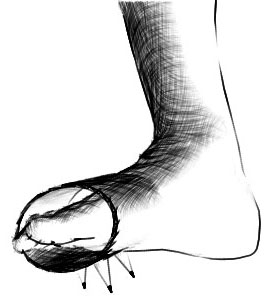
The counterpart to the shukō is the ashi kō. A device similar to that on the hand was placed under the Ninja’s foot. Getting kicked made worse injuries that way, and climbing was far easier.
Baku hatsu gama

At the end of the bakuhatsugama, the Ninja attached explosives, poisons, or blinding powder. He threw it in the attacker’s face and then attacked him with the sickle.
Bisentō

The heavy halberd was introduced from China and required a different style of fighting than the naginata. It was far more massive, and in the hands of a strong warrior a formidable weapon.
Bō
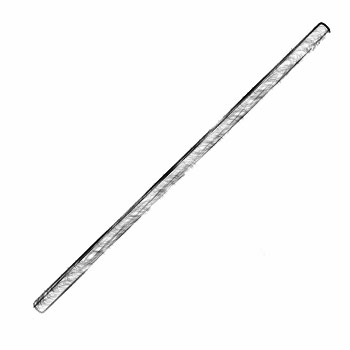
One of the simplest weapons was probably the staff or stick. What is known today as the bō is actually the roku shaku bō with a length of approximately 182 cm. At first glance, the weapon doesn’t look very dangerous, but in the hands of a master, this all-purpose weapon is deadly. It could be used to stab or slash, and was also very effective against multiple opponents, making it a popular weapon among Ninja.
Bō shuriken
Knife- or arrow-shaped, elongated shuriken.
Bō ken

Also bokken or bokutō. Wooden sword made of heavy wood for practice. Usually even heavier than a sharp sword, it was a relief for the student when he got his daishō.
Bokken
Also bōken or bokutō.
Bokutō
Also bōken or bokken.
Chi giri ki
A long stick and a chain with an iron weight on the end. Originally developed by farmers from the flail to defend themselves against attackers.
Daisharin

The daisharin consisted of two wheels with an axle. The Ninja liked to use it to knock down larger groups of attackers or to use it as an improved staff.
Daishō
Big-small, the designation for the pair of swords of the Samurai (katana and wakizashi). Actually, only the Samurai were allowed to carry two swords, but a Ninja didn’t care, because as a non-noble he wasn’t allowed to carry weapons anyway.
Daitō
Big Sword, a sword with a particularly long blade (between 60 and 180 cm).
Eiku
Boat rudder, actually an Okinawan weapon. When the Ninja was in disguise as a fisherman, it was a good way to defend himself.
Endoku ken

The Ninja also used throwing stars that released poisonous smoke when lit. In this way, one could force hidden enemies to reveal themselves.
Fukiya

The blowgun was popular because it could kill the enemy quietly. The bolts were poisoned, stifling every scream. Disguised as a flute, a blowgun could be carried around freely.
Fukumi bari
Small darts that the Ninja spat in an attacker’s face.
Futokoro teppō
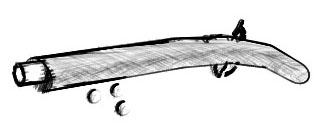
The bronze pistol was popular with the Ninja because it was small and easy to conceal. Sometimes a bayonet was put on the gun.
Hanbō

The half staff or stick, although very short at 3 feet, was a very effective weapon. The correct term is actually sanshakubō.
Hankyū

The half staff or stick, although very short at 3 feet, was a very effective weapon. The correct term is actually sanshakubōa. The bow of the Ninja was far shorter than the bow of the Samurai. This made it easier to transport and hide. The shorter range usually didn’t matter much, as Ninja rarely needed to hit distant targets on the battlefield, most of the time only close targets. Explosives or incendiary materials were often attached to the arrows, especially since almost all buildings in Japan were made of wood. You could also use special arrows to cut ropes or create a howling sound that terrified enemies.
Hira shuriken
Star-shaped flat throwable objects.
Hishi
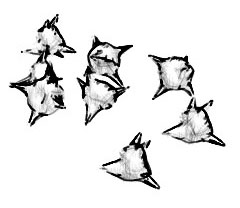
Dried water chestnuts served the same purpose as the tetsubishi but were easier to obtain. In addition, they did not arouse suspicion, because in rural areas this plant was quite common.
Iga dama

This weapon could be used in a similar way to the tetsubishi, in addition to being thrown at enemies. They liked to be hidden all over the Ninja house to defend themselves against attackers.
Jirai
Also Uzume bi.
Jō

The walking stick was a shortened form of roku shaku bō. It reached the waist or abdomen and could be used in a similar way to the staff. Its proper term is yon shaku bō.
Jutte
Hand weapon with a hook that could be used to intercept a sword attack.
Kagi yari

Also kama yari. Togakure-Ryū and kumogakure-Ryū Ninja often used the hook spear. You could get into trees, over walls, or onto ships. It was also possible to get from tree to tree in this way. Hidden on a high post, a victim could be caught with the hook and pulled up. It was also suitable for fishing, breaking down doors, or transporting luggage.
Kama

Short-handled sickle used in Asia to cut rice, corn, or sugar cane.
Kama yari
Also kagi yari.
Kanzashi
Fork-shaped hairpin. Often used as a weapon by the kunoichi.
Katana
Samurai longsword, with a curved blade, manufactured in a complex forging process with different degrees of steel hardness, the best sword weapon in the world, with a blade length of 61 to 76 cm.
Kogai
Sword pin or hairpin. The sword needle was actually a tool placed on the side of the saya. But it could also be used as a throwing or thrusting weapon.
Kongō

Sanskrit Vajra. The scepter symbolizes the diamond, used by esoteric sects. Also served as a baton.
Kubotan
Also yawara. Percussion weapon, in the shape of a cylinder. Suitable for grab handles or to apply pressure to joints. Similarities in usage in kongō.
Kusari fundō

Also manrikigusari. The chain was a useful weapon. It could be easily concealed and was even suitable for intercepting sword blows, binding opponents, choking them, or knocking them off their feet.
Kusarigama

The kusarigama was a popular weapon. Attached to a rice sickle was a chain one to two meters long. A weight was attached to the end of the chain. When attacked, a Ninja would throw the weight around the attacker’s blade, forcing the attacker to lower his weapon. After that, he attacked the enemy with the sickle.
Ku shaku bō
Extra-long stick (270 cm).
Kyoketsu shoge

Probably the Ninja’s most popular weapon was the kyoketsu shoge. A knife with a hook, an 18-foot (est. 5,49 m) long rope attached to the handle, and a steel ring at the end. The rope was often made of women’s hair since hair was particularly strong. With this weapon, the Ninja could control the opponent’s weapon, attack with the knife, block a sword stroke with the hook, or knock the enemy off their feet. He could climb and tie with the rope and firecrackers could also be attached to the steel ring to blind the enemy.
Kyū
Also yumi.
Mamukugama

With this weapon, a poisonous animal was attached to the end of the rope, such as a snake. This was thrown at the enemy and this made the fight much easier because the animal kept the enemy busy and maybe even killed them.
Manriki gusari
Also kusari fundō. A chain with the power of 10,000
. Chain with lengths from 40 to 400 cm and weights at the ends. Was developed in the 17th century by Masaki Toshimitsu, a gatekeeper in Edo, as a defensive weapon against swords.
Metsubushi
When a Ninja was spotted, they were usually outnumbered. To escape safely, however, he used blinding powder to limit the enemy’s vision. In eggshells or nutshells, he kept a powder consisting of chemicals, ash, sand, iron filings, pepper, or nettle hairs. It could blind the enemy for a short time, or it could destroy eyesight forever.
Nageteppō
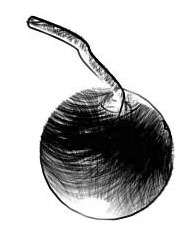
These explosive grenades were thrown at the enemy by hand or with slingshots and worked on the same principle as a hand grenade does today.
Naginata

The sword spear was a sōhei weapon and the weapon of choice for Samurai women. They came in different forms (e.g. nagamaki), varying in blade-to-handle ratio, length, and blade thickness. It was a very effective weapon against mounted warriors, long as a spear and capable of severing limbs. After World War II it was used predominantly by women in the naginatadō.
Nagishi-shuriken
Also bō-shuriken. Arrow-shaped projectiles that had a tassel at the end for flight stabilization.
Neko te

The kunoichi sometimes wore such a cat’s claw on each finger. It could inflict terrible wounds on an attacker’s face.
Ninja tō

Also Ninjaken or Shinobi katana. The short sword was an important tool in Ninja equipment. It wasn’t pretty or valuable like the tachi or katana of the Samurai – it was useful. The blade was much shorter than that of the katana or the tachi. So the Ninja could move better with it and use it in close combat. The blade was sometimes straight, but sometimes it was just a shortened katana. The tsuba was not decorated with beautiful ornaments but mostly larger and made of simple steel, often angular. So you could use it as a climbing aid. The sword was carried at the side and only rarely (e.g. when climbing) over the back or stomach. Poisons, medicines, or chemicals were often hidden in the handle. The saya could be used as a blowpipe or a breathing tube.
Ninja ken
Also Ninja tō or Shinobi katana.
Nodachi
Very long Samurai swords with blade lengths of 100 to 180 cm, carried either on the back or by a servant.
Nuntebō
A fishing spear is a tool used by fishermen, but it could also be used as a weapon.
Ōgama

The ōgama was the battlefield version of the kusarigama. The chain was strong enough to knock horses off their feet. The sickle could pierce or cut through armor with ease.
Ono

The heavy war ax was brought from China after the fall of the T’ang Dynasty. It could smash through castle gates, knock warriors from their horses, or nullify any attack with a weaker weapon.
Ōzutsu

Togakure-Ryū Ninja used wooden cannons from very early on to be victorious in larger battles. This weapon was very effective against larger cavalry units or castle gates.
Ono gama
A weapon consisting of a heavy war ax and a kama. Used by the sōhei and the Ninja.
Roku shaku bō
A shaku was 30.3 cm. Roku means six. The exact term for the bō.
San shaku bō
A shaku was 30.3 cm. San means three. The exact term for the Hanbō.
Sembanshaken
Term for a shuriken with a hole in the middle.
Shaken
Shuriken with multiple prongs.
Shakuhachi
Flute, 30.3 cm (1 shaku) long with eight (hachi) lateral holes. The flute was used by the komusō. Ninja liked to disguise their blowgun as a shakuhachi.
Shakujō

The staff of the priests was often used when a Ninja disguised himself as a monk. The staff has rings at the end, the sound of which the monk used to drive crawling animals off the path so that he could observe the law of non-killing and not accidentally step on an animal.
Shikomizue

When a Ninja was on the move, he couldn’t always carry a sword openly with him. The shikomizue was a sword hidden in a stick. Outwardly it looked like an ordinary staff, but that could be changed quickly.
Shinobi shobō

The shinobi shobō is a predecessor of today’s brass knuckles and works in the same way. The middle finger is put through a steel ring and the rest of the weapon is hidden in the fist.
Shinobi katana
Also Ninja tō or Ninja ken.
Shinobi kai
Also shinobi zue.
Shinobi tantō
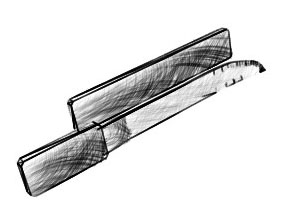
The Ninja also used tantō, like the Samurai. But then they were mostly camouflaged or hidden in clothing. The shinobi tantō was disguised as a short stick, similar to the shikomi zue.
Shinobi zue

Also shinobi kai. The Ninja liked to use staffs and sticks because carrying them was considered commonplace in Japan’s Middle Ages. Everyone carried a staff with them while hiking. Only the staves of the Ninja were modified. Usually, they were hollow, and inside were hidden knives, poisons, blinding powder, or chains with weights. When a Ninja was attacked, he quickly opened the staff’s cover and an iron ball attached to a chain flew out and the Ninja was able to use it to knock the enemy off his feet. Or he hurled poison, blinding powder, or other weapons at him. This is how a normal walking staff quickly turned into a spear, poison splatter, or morning star.
Shukō

Also tekagi. A terrible weapon is the shukō. A pointed iron prong was attached to a kind of leather arm ring, whereby the Ninja turned his hand into a tiger claw. The spikes could inflict terrible wounds on the attacker’s face. With this weapon, the Ninja could also take swords, i.e. stop the sword strike. At the same time, the Ninja could climb up walls or trees better. The counterpart for the feet was called ashi kō.
Shuriken

The most famous weapons were the throwing blades. As hira shuriken in star form or as bō-shuriken in dagger form. Each weapon required its own throwing technique. The throwing blades could be poisoned and also used in close combat. The senban shaken was the typical throwing star of Togakure-Ryū. It had four points and looked like a diamond. There was a hole in the middle. The sides were ground sharp. The throwing star was very thin and light, so nine could always be carried together in the inside pocket.
Sodezutsu

The smaller brother of the ōzutsu was the sodezutsu. This cannon could be fired from the hand and was a forerunner of rifles.
Tachi
Old longsword with a blade 61 to 76 cm long. The tachi was usually more curved at the handle than the katana and was fastened horizontally with the blade down on the belt in front of the body. The katana was tucked into the belt with the blade up. Initially used as a battle sword, later mostly only for ceremonial occasions.
Tanegashima

Also teppo. The Ninja were probably the first to see the utility of the arquebuses that the Portuguese introduced to Japan. Long before the weapon was used in battle, it was used in assassination attempts by the Ninja.
Tantō
Dagger. The blade was less than 30 cm long. The tantō was used as a defensive weapon by many people from all walks of life.
Tekagi
Also shukō.
Tekkō
Brass knuckles, exactly like modern brass knuckles in appearance and function.
Teppō
Also tanegashima.
Tessen
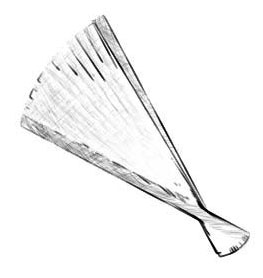
The War Fan was a popular weapon because it didn’t look like a weapon at first glance. With the fan, the outer parts were made of steel, sometimes it wasn’t even a fan at all but just a piece of steel in the shape of a fan. With this weapon, you could inflict pain on the joints or control it with it.
Tetsubishi

When a Ninja was being pursued, he would scatter a handful of these iron metal spikes on the ground. Since straw sandals were worn in Japan, it was extremely painful to step on the thorns and a pursuit could not continue. What was brilliant about this weapon was that no matter how you threw it, there was always a spike sticking up. Also occurs naturally in nature (hishi).
Tetsubō

This weapon was probably used all over the world and is one of the most primitive. Steel spikes were attached to a mace to increase effectiveness.
Toami

The web was used by the Ninja to defend themselves against a variety of attackers. In the fishing villages, it was an everyday tool and was hardly noticed. It could also be set up in forests or corridors as a trap.
Tonki
Also shuriken.
Torinawa
A pointed shaft attached to a chain or string and had a weight at the end.
Tori no ko
firecrackers. Imported early from China. Only used to distract and confuse. Later, after the introduction of black powder, explosives were also manufactured.
Uzume bi
Also jirai. These land mines were buried deep underground. An enemy who stepped on the box set the firing mechanism in motion and was killed or seriously wounded by an explosion.
Wakizashi
Companion of the Belt, a short sword resembling its larger image the katana. Together with the katana formed the daishō.
Wakizashi teppō

Concealed inside a traditional short sword was a pistol that could fire one shot.
Yon shaku bō
A shaku was 30.3cm. Yon means four. The exact term for the jō.
Yari
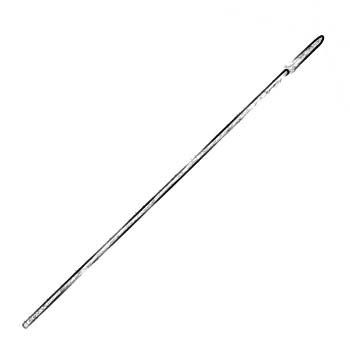
The Japanese spears were designed to stab and were rarely thrown. With its small point, one could easily fit between the plates of the Samurai armor. The tips were mostly two- or three-sided. It was usually 200 to 350 cm long. Oda Nobunaga used yari, some 640 cm long, to protect his teppō soldiers against cavalry.
The Ninja often used the yari to high jump over walls or people.
Yawara
Also kubotan.
Yumi
Also kyū. Arrow (ya) and bow (yumi). The Japanese bow was made from different layers of wood or bamboo and is approximately 220 cm long. It is one of the few bows in the world with an asymmetrical shape. The arrow rests in the lower third.